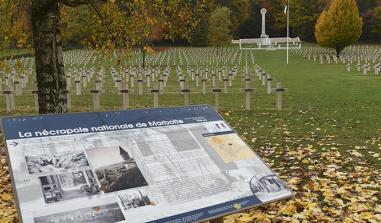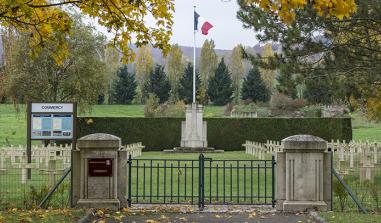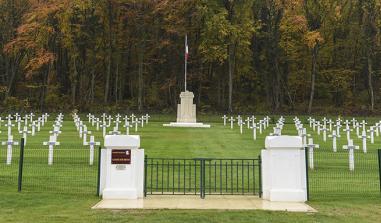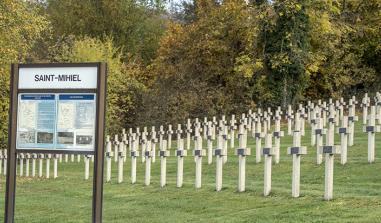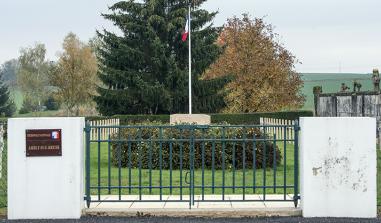Destroyed village of Beaumont en Verdunois

Chapelle du village détruit de Beaumont. Photo Office de Tourisme de Verdun
A chapel with a monument in front of it stands on the site of the destroyed village.
Beaumont seems to have been founded in 324, at the end of the Gallo-Roman period; its first name was "super fluvium orna" ("above the River Orne"). Afterwards the village was successively called Bellusmons, Blermont, Byaumont and Beaumont.
In the early Middle Ages the Abbess of Juvigny-sur-Loison had high seigneury rights over Beaumont, whose inhabitants paid her the tithe. In August 1252, Beaumont was freed by the Count of Bar and the Abbess of Juvigny. In 1635 and 1636, during the Thirty Years' War, Hungarian, Polish and Swedish troops ravaged the area, burning down villages and massacring the inhabitants. The population of Beaumont found refuge in fortified castle at Ornes but a plague epidemic broke out, killing 430 people, including 22 from Beaumont. Around 1700, Monsignor de Béthume, bishop of Verdun, elevated Beaumont to a presbytery. The first church built in the middle of the cemetery was replaced by another in 1786-1787, which stood on the site of the present First World War monument in the village centre. The Prussians then invaded Beaumont in 1815 and the Germans in 1870, when a regiment of cuirassiers entered the village on 24 August. Beaumont is 15 km northeast of Verdun. Its land area is 787 hectares. In 1911, the census recorded 186 inhabitants. In September 1914, Beaumont's residents were evacuated to southern France. From mid-August to mid-October, Beaumont was between the two lines, a six- to seven-kilometre wide no man's land stretching from Louvemont to the woods north of the village. The German artillery destroyed the church in early October. In mid-October, French troops occupied a line from the northern crescent of Caures Wood to Ville Wood and the hamlet of Soumazannes. All the land that was administratively part of the village was in the French zone until February 1916. Attack and capture of Beaumont - 24 February 1916. The relative quiet suddenly ended on 21 February 1916. Despite the chasseurs' heroic resistance, Caures Wood fell. Colonel DRIANT wanted to retreat to Beaumont, probably by the old Flabas road, which leads to Gobi (territory of Beaumont). When the columns emerged from Champneuville Wood, they came under withering German machine-gun fire. The colonel, who was bringing up the rear, was killed, but fragments of sections managed to reach Beaumont and reinforce the garrison there. 24 February was a crucial day. The sky was grey, snow covered the ground and it was bitterly cold. The battle for Beaumont was about to begin. In the village, components of two French regiments (four companies) fought off repeated attacks. As the troops of the 18th German Corps entered the village, machine guns firing from cellar windows mowed them down. The enemy formations, which were particularly dense, advanced so quickly, with each wave passing the previous one, that the French automatic fire seemed to overwhelm them and they suffered terrible losses. The Germans started systematically shelling the village again. When they attacked again they still met with resistance but the balance of forces was too uneven. A few troops managed to break through and reach Louvemont. Beaumont fell on the afternoon of 24 February 1916.
At 6 p.m. on the same day, silent hand-to-hand fighting continued in the woods near Joli-Coeur. To the west, a company's tattered remnants struggled to contain the Germans, who were trying to reach Anglemont Ridge. Suddenly a large, cheering party of Germans left Beaumont on the Rue du Moulin and reached the national road. This time the retreat was cut off. The battalion commander rallied a few company remnants (approximately 60 men), had a still-able-bodied bugler sound the charge, and thrust himself and this handful of brave men in front of the enemy on the Anglemont. Against all odds, the Germans stopped. Surprised, they did not even fire a shot. Better yet, they fell back, unaware of how exhausted the French troops were. The Germans did not try again, enabling the French to keep the road open as an escape route. Only when they were ordered to, on 25 February at 2 a.m., did the survivors of the 2nd Battalion of the 60th RI reach the côte du Poivre (Pepper Hill) by way of the Vaux meadow, Vacherauville ravine and Grillot Woods. "Partial reconquest of Beaumont - August 1917. The 32nd Army Corps including four infantry divisions led the attack in the Beaumont sector. From 20 to 26 August, the Germans turned the village into a formidable fortress, which underwent relentless shelling. On 26 August, two regiments, the 154th RI and the 155th RI, attacked but failed to take Beaumont, which remained in German hands. On 2 September, a final French offensive failed to retake the Beaumont sector. The US Army occupied Beaumont in the earliest days of November 1918.
1919 - The postwar period Beaumont was declared a "red zone", meaning that it was forbidden to rebuild the village and return the land to farming. In 1920, the prefect appointed a municipal commission. In 1925, a monument was built to the memory of the children of Beaumont who died for France. Afterwards, to honour the ancestors' memory and pay another tribute to the native sons who died on the battlefield, the interior of the cemetery was levelled, the walls raised and a monument erected engraved with the text of the army's citation to the village and the names of its war dead. The chapel was built in 1932-1933. In 1932, the decision was taken that on the fourth Sunday in September, the patron saint's feast day (Saint Maurice), "the former inhabitants and their families would gather to honour their dead and breathe the air of the land where they were born", a tradition that carries on today.
Practical information
55100
Beaumont-en-Verdunois
Accessible toute l'année



